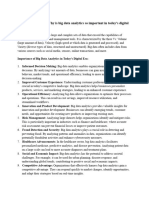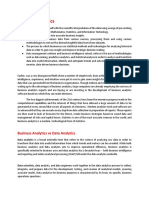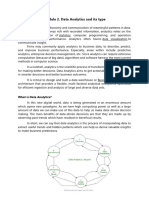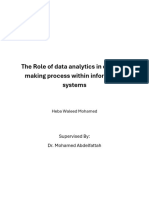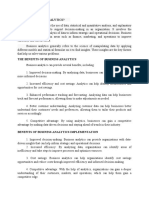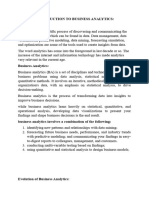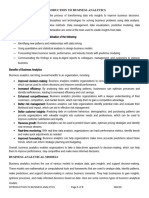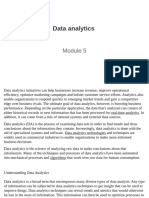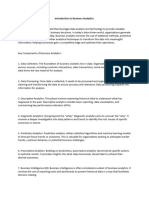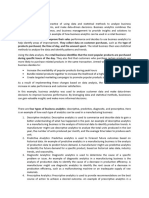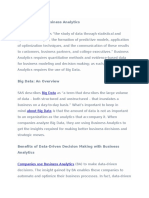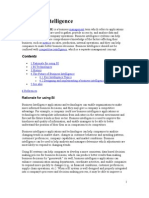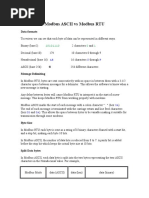Chapter-I Introduction to Data Analytics
Uploaded by
ANKITHChapter-I Introduction to Data Analytics
Uploaded by
ANKITHVardhaman College of Engineering Business Analytics
BUSINESS ANALYTICS (C5024)
Chapter – I: INTRODUCTION TO DATA ANALYTICS
INTRODUCTION TO DATA ANALYTICS: Introduction to Data for Business Analytics,
Importance of Analytics, Big Data, SAS, Business Analytics in Practice. Data Visualization,
Data Visualization Tools, Data Queries, Statistical Methods for Summarizing Data, Exploring
Data using Pivot Tables.
1. Introduction to Data Analytics
Data analytics is the science of examining raw data to make informed decisions. It involves
techniques and tools to convert data into meaningful insights that drive strategic decision-
making. Data analytics is integral to modern business operations, providing organizations with
the ability to understand their customers, optimize processes, and create a competitive edge.
Introduction to Data for Business Analytics
In the context of business analytics, data serves as the foundation for deriving insights and
making data-driven decisions. Business data can be categorized into various types, including:
1. Operational Data: Collected from daily business operations, such as sales transactions,
customer service interactions, and inventory management.
2. Financial Data: Includes financial statements, profit and loss reports, and other
accounting records essential for evaluating a company's financial health.
3. Customer Data: Encompasses demographic information, purchase history, preferences,
and feedback, which helps businesses understand and cater to their customers.
4. Social Media Data: Gathered from platforms like Facebook, Twitter, and Instagram, this
data provides insights into brand perception and customer engagement.
5. Web Data: Involves data collected from websites, including user behavior, traffic
patterns, and conversion rates, useful for digital marketing and e-commerce strategies.
2. Importance of Data for Business Analytics
1. Informed Decision-Making: Data-driven decisions are typically more accurate and
reliable, minimizing the risks associated with gut-feeling or assumption-based decisions.
2. Identifying Trends: Analyzing historical and real-time data helps businesses identify
trends and patterns that can influence future strategies.
Dr. S. Venkata Siva Kumar Page | 1
Vardhaman College of Engineering Business Analytics
3. Customer Insights: Understanding customer behavior, preferences, and needs through data
analytics enables businesses to tailor their products, services, and marketing efforts more
effectively.
4. Operational Efficiency: Data analytics can uncover inefficiencies in business processes,
leading to streamlined operations and cost savings.
5. Competitive Advantage: Companies that leverage data analytics can respond more quickly
to market changes, innovate faster, and gain a competitive edge over rivals who rely on
traditional decision-making methods.
6. Performance Measurement: Analytics provides the tools to measure the effectiveness of
business strategies and initiatives, enabling continuous improvement and better resource
allocation.
3. Big Data
Big Data refers to large and complex data sets that traditional data processing software cannot
handle efficiently. The term not only refers to the volume of data but also to the variety,
velocity, and veracity of the data. Big Data encompasses structured, semi-structured, and
unstructured data from various sources such as social media, IoT devices, sensors, and more.
3.1 Characteristics of Big Data (The 4 Vs)
1. Volume: Refers to the massive amounts of data generated every second. For example, social
media platforms like Facebook and Twitter generate terabytes of data daily through posts,
shares, likes, and comments.
2. Variety: The different types of data being generated. This includes text, images, videos,
logs, and transactional data, each requiring different analytical approaches.
3. Velocity: The speed at which data is generated and processed. For example, in financial
markets, data needs to be processed in real-time to make quick decisions.
4. Veracity: The quality and accuracy of the data. High veracity implies that the data is clean
and trustworthy, while low veracity indicates noise or uncertainty in the data.
3.2 Importance of Big Data
Customer Insights: Big Data analytics allows businesses to gain deep insights into
customer behavior, preferences, and trends. For example, Amazon uses Big Data to
recommend products to users based on their browsing and purchase history.
Dr. S. Venkata Siva Kumar Page | 2
Vardhaman College of Engineering Business Analytics
Operational Efficiency: Companies like UPS use Big Data to optimize delivery routes,
saving time and reducing fuel consumption.
Innovation: Big Data can reveal trends that lead to new product developments or service
enhancements. For instance, Netflix uses Big Data to produce original content by analyzing
viewer preferences.
Risk Management: Financial institutions use Big Data to detect fraudulent activities and
manage risks by analyzing transaction patterns.
4. SAS (Statistical Analysis System)
SAS is a powerful software suite used for advanced analytics, business intelligence, data
management, and predictive analytics. It is widely used in industries such as healthcare,
finance, and retail for data analysis and reporting.
4.1 Features of SAS
1. Data Management: SAS provides tools for data cleaning, transformation, and integration.
It can handle large volumes of data from various sources like databases, spreadsheets, and
external files.
2. Advanced Analytics: SAS supports complex statistical analysis, including regression,
classification, clustering, and time-series analysis.
3. Business Intelligence: SAS enables the creation of dashboards and reports that provide
insights into business performance, helping managers make data-driven decisions.
4. Predictive Modelling: SAS allows users to build predictive models that forecast future
trends, such as customer churn or sales growth.
4.2 Example of SAS in Practice
Healthcare: SAS is used to analyze patient data to improve treatment outcomes. For
example, hospitals use SAS to predict patient readmission rates and adjust care plans
accordingly.
Finance: Banks use SAS to assess credit risk by analyzing customer credit histories and
predicting the likelihood of default.
Retail: Retailers like Walmart use SAS to optimize pricing strategies and inventory
management by analyzing sales data and customer behavior.
Dr. S. Venkata Siva Kumar Page | 3
Vardhaman College of Engineering Business Analytics
5. Business Analytics in Practice
Business Analytics refers to the process of using statistical analysis, predictive modelling, and
data mining to explore and analyze data, thereby making informed business decisions. Business
analytics is applied across various industries to improve efficiency, increase profitability, and
enhance customer satisfaction.
Examples of Business Analytics in Practice
1. Retail Industry:
Customer Segmentation: Retailers use business analytics to segment customers based on
purchasing behavior, demographics, and preferences. For example, Target uses data analytics
to send personalized promotions to customers based on their shopping history.
Inventory Management: Business analytics helps retailers predict demand and manage
inventory levels efficiently. Walmart uses advanced analytics to forecast demand for products
during peak seasons, ensuring shelves are stocked appropriately.
2. Finance Industry:
Fraud Detection: Banks use business analytics to detect fraudulent activities by analyzing
transaction patterns. For example, credit card companies analyze spending behavior in real-
time to identify unusual activities that may indicate fraud.
Risk Management: Financial institutions use predictive analytics to assess and mitigate risks.
For instance, insurance companies analyze historical data to predict the likelihood of claims
and adjust premiums accordingly.
3. Healthcare Industry:
Patient Care Optimization: Hospitals use business analytics to improve patient outcomes by
analyzing treatment data, patient demographics, and disease patterns. For example, Kaiser
Permanente uses analytics to identify high-risk patients and implement preventive measures.
Resource Allocation: Business analytics helps healthcare providers allocate resources
efficiently by predicting patient inflow and optimizing staff schedules.
4. Manufacturing Industry:
Predictive Maintenance: Manufacturers use business analytics to predict equipment failures
and schedule maintenance before breakdowns occur. For instance, GE uses predictive analytics
to monitor machinery and reduce downtime.
Dr. S. Venkata Siva Kumar Page | 4
Vardhaman College of Engineering Business Analytics
Supply Chain Optimization: Business analytics helps manufacturers optimize their supply
chain by analyzing data from suppliers, production processes, and logistics. Toyota uses
analytics to manage its just-in-time inventory system effectively.
Big Data, SAS, and business analytics are crucial elements in modern business practices.
Understanding Big Data's characteristics allows companies to harness vast amounts of
information to drive innovation and improve decision-making. SAS provides the tools
necessary for sophisticated data analysis, while practical applications of business analytics
demonstrate how these concepts are implemented across industries to achieve tangible benefits.
Together, these components form the backbone of data-driven strategies that can propel
businesses to new heights in today’s competitive landscape.
6. Data Visualization
Data Visualization is the graphical representation of information and data. By using visual
elements like charts, graphs, and maps, data visualization makes it easier to identify patterns,
trends, and outliers in data sets. The main purpose of data visualization is to communicate
information clearly and efficiently to users by turning complex data into visual context.
6.1 Importance of Data Visualization
1. Simplifies Complex Data: Large and complex data sets can be hard to interpret in tabular
format. Visuals help distil the data, making it more comprehensible.
2. Reveals Insights: Visualization helps detect patterns, trends, and correlations that may not
be evident in raw data.
3. Decision-Making Support: Effective visualization allows stakeholders to make quicker
and better decisions based on the presented data.
4. Improves Communication: Data visualization makes it easier to communicate findings
and analyses to a non-technical audience.
6.2 Types of Data Visualizations
1. Bar Charts: Used to compare different categories of data.
2. Line Charts: Show trends over time or continuous data.
3. Pie Charts: Represent proportions within a whole.
4. Scatter Plots: Demonstrate relationships between two variables.
Dr. S. Venkata Siva Kumar Page | 5
Vardhaman College of Engineering Business Analytics
5. Heat Maps: Show the intensity of data at different points.
7. Data Visualization Tools
Various tools are available for creating visual representations of data. Some of the most
commonly used data visualization tools are:
7.1 Excel: Excel is a versatile tool for creating various types of charts and graphs, such as bar
charts, line charts, pie charts, and more. It is particularly useful for small to medium-sized data
sets and provides robust features for summarizing and visualizing data.
Example: Excel is commonly used by businesses to create visual reports, track performance
metrics, and generate dashboards using built-in charting tools like pivot charts.
7.2 Tableau: A powerful data visualization tool that allows users to create interactive
dashboards and reports.
Example: Tableau is used by companies like LinkedIn to track user engagement across
different pages and demographics.
7.3 Power BI: Microsoft’s tool for building dashboards and reports, enabling real-time
monitoring of data from various sources.
Example: Retailers use Power BI to visualize sales performance across regions and product
lines.
7.4 Google Data Studio: A free tool that turns raw data into customizable dashboards and
reports.
Example: Digital marketers use Google Data Studio to monitor campaign performance by
integrating Google Analytics and Ads.
8. Data Queries
Data Queries are requests for specific information from a database. A query can retrieve data,
update records, or delete information from databases, and they are essential for data analysis.
8.1 Types of Data Queries:
1. Select Query: Retrieves specific data from one or more tables.
Dr. S. Venkata Siva Kumar Page | 6
Vardhaman College of Engineering Business Analytics
Example: Selecting all records from a customer table where the customer resides in a particular
city.
2. Update Query: Modifies data in one or more records.
Example: Updating the status of orders to "shipped."
3. Delete Query: Removes records from a table.
Example: Deleting customer records that have not made purchases in the past five years.
4. Join Query: Combines rows from two or more tables based on a related column.
Example: Combining data from a customer and an orders table to view which customers
placed orders.
9. Statistical Methods for Summarizing Data
Summarizing data involves condensing data into understandable forms, such as using averages,
measures of spread, and visual representations.
9.1 Key Statistical Methods:
1. Measures of Central Tendency:
Mean (Average): The sum of all values divided by the number of values.
Median: The middle value in an ordered data set.
Mode: The most frequently occurring value in a data set.
Example: In a set of exam scores, the mean score helps summarize the overall performance
of the students.
2. Measures of Dispersion:
Range: The difference between the maximum and minimum values.
Variance: The average of the squared differences from the mean.
Standard Deviation: A measure of the spread of data points from the mean.
Example: In a sales dataset, a high standard deviation indicates fluctuating sales numbers.
3. Percentiles and Quartiles:
Percentiles: Indicate the relative standing of a value within a data set (e.g., the 90th
percentile means 90% of the data points are below this value).
Dr. S. Venkata Siva Kumar Page | 7
Vardhaman College of Engineering Business Analytics
Quartiles: Divide the data into four equal parts.
Example: Percentiles are used in standardized testing to rank students' performance.
4. Frequency Distributions:
A summary showing the number of occurrences of each value or group of values in a dataset.
Example: A histogram shows the frequency distribution of customer age ranges in a store's
dataset.
10. Exploring Data Using Pivot Tables
Pivot Tables are one of the most powerful features in spreadsheet programs (e.g., Excel,
Google Sheets) for exploring, summarizing, and analyzing data. They allow you to
automatically sort, count, and total data stored in a spreadsheet and to display it in a customized,
interactive table.
Uses of Pivot Tables:
1. Summarize Data: You can quickly calculate totals, averages, or other statistics for data
grouped by various categories.
Example: Summarizing sales by product category and region using a pivot table.
2. Filter and Sort Data: Pivot tables allow for data filtering and sorting, helping to focus on
specific data points.
Example: Sorting sales data by year to see how performance has changed over time.
3. Creating Subtotals and Grand Totals: Pivot tables can automatically calculate subtotals
and grand totals across rows and columns.
Example: Displaying total revenue for each product category and a grand total for all
categories combined.
4. Group Data: Grouping by dates, values, or custom criteria allows for more granular
analysis.
Example: Grouping sales data by quarters or by custom ranges (e.g., $0–$1000, $1001–
$2000).
Dr. S. Venkata Siva Kumar Page | 8
Vardhaman College of Engineering Business Analytics
10.1 Steps to Create a Pivot Table in Excel:
1. Insert the Pivot Table: Select your dataset, go to the Insert tab, and click "Pivot Table."
2. Arrange Fields: Drag and drop data fields into Rows, Columns, Values, and Filters sections
to organize the table.
3. Customize Calculation: Choose from calculations like sum, average, count, and more for
the values field.
4. Filter the Data: Use filters to narrow down the dataset to specific categories, regions, or
periods.
Example: A company wants to analyze sales data by region and product type. Using a pivot
table, the company can quickly see which regions have the highest sales for each product type
and the overall totals for each region.
Dr. S. Venkata Siva Kumar Page | 9
You might also like
- Oracle Database 19c Data Guard Administration Workshop100% (1)Oracle Database 19c Data Guard Administration Workshop3 pages
- Slide Asm1 1st Bps Phamngoclong Bh01131No ratings yetSlide Asm1 1st Bps Phamngoclong Bh0113124 pages
- The Role of Data Analytics in Decision Making Process Within Information SystemsNo ratings yetThe Role of Data Analytics in Decision Making Process Within Information Systems11 pages
- Introduction To Data Science and Basic Statistics For BusinessNo ratings yetIntroduction To Data Science and Basic Statistics For Business3 pages
- Business Analytics: Leveraging Data for Insights and Competitive AdvantageFrom EverandBusiness Analytics: Leveraging Data for Insights and Competitive AdvantageNo ratings yet
- Unit-1 - Introduction To Business AalyticsNo ratings yetUnit-1 - Introduction To Business Aalytics25 pages
- Unit-1 - Introduction To Business AalyticsNo ratings yetUnit-1 - Introduction To Business Aalytics19 pages
- Overview of Business Analytics and Its Significance in Decision-MakingNo ratings yetOverview of Business Analytics and Its Significance in Decision-Making8 pages
- Role of Business Analytics in Decision MakingNo ratings yetRole of Business Analytics in Decision Making17 pages
- Artificial Intelligence Big Data 01 Research PaperNo ratings yetArtificial Intelligence Big Data 01 Research Paper32 pages
- Business Analytics Handout Using Excel 6thNo ratings yetBusiness Analytics Handout Using Excel 6th12 pages
- Business Intelligence: "Learn As You Grow"No ratings yetBusiness Intelligence: "Learn As You Grow"18 pages
- Forensic Analysis of Windows 7 Jump ListsNo ratings yetForensic Analysis of Windows 7 Jump Lists48 pages
- Brief Introduction To R Kaustav Banerjee: Decision Sciences Area, IIM LucknowNo ratings yetBrief Introduction To R Kaustav Banerjee: Decision Sciences Area, IIM Lucknow7 pages
- CS304P Assignment 2 Solution by M.junaid QaziNo ratings yetCS304P Assignment 2 Solution by M.junaid Qazi5 pages
- Deadlock in DBMS: Rabeya Tus Sadia Lecturer, Dept. of CSE State University of BangladeshNo ratings yetDeadlock in DBMS: Rabeya Tus Sadia Lecturer, Dept. of CSE State University of Bangladesh12 pages
- Spasial Statistik Untuk Estimasi Dan Peramalan Produksi PertanianNo ratings yetSpasial Statistik Untuk Estimasi Dan Peramalan Produksi Pertanian13 pages
- The Study Is To Assess The Computer Knowledge in The Use of Integrated Financial Management Systems in Government SectorsNo ratings yetThe Study Is To Assess The Computer Knowledge in The Use of Integrated Financial Management Systems in Government Sectors46 pages
- Explain UNION and UNION ALL SQL Clause With ExampleNo ratings yetExplain UNION and UNION ALL SQL Clause With Example8 pages
- Download ebooks file Dynamic and Advanced Data Mining for Progressing Technological Development Innovations and Systemic Approaches Premier Reference Source 1st Edition A. B. M. Shawkat Ali all chapters100% (2)Download ebooks file Dynamic and Advanced Data Mining for Progressing Technological Development Innovations and Systemic Approaches Premier Reference Source 1st Edition A. B. M. Shawkat Ali all chapters67 pages
- Oracle Database 19c Data Guard Administration WorkshopOracle Database 19c Data Guard Administration Workshop
- The Role of Data Analytics in Decision Making Process Within Information SystemsThe Role of Data Analytics in Decision Making Process Within Information Systems
- Introduction To Data Science and Basic Statistics For BusinessIntroduction To Data Science and Basic Statistics For Business
- Business Analytics: Leveraging Data for Insights and Competitive AdvantageFrom EverandBusiness Analytics: Leveraging Data for Insights and Competitive Advantage
- Overview of Business Analytics and Its Significance in Decision-MakingOverview of Business Analytics and Its Significance in Decision-Making
- Artificial Intelligence Big Data 01 Research PaperArtificial Intelligence Big Data 01 Research Paper
- Brief Introduction To R Kaustav Banerjee: Decision Sciences Area, IIM LucknowBrief Introduction To R Kaustav Banerjee: Decision Sciences Area, IIM Lucknow
- Deadlock in DBMS: Rabeya Tus Sadia Lecturer, Dept. of CSE State University of BangladeshDeadlock in DBMS: Rabeya Tus Sadia Lecturer, Dept. of CSE State University of Bangladesh
- Spasial Statistik Untuk Estimasi Dan Peramalan Produksi PertanianSpasial Statistik Untuk Estimasi Dan Peramalan Produksi Pertanian
- The Study Is To Assess The Computer Knowledge in The Use of Integrated Financial Management Systems in Government SectorsThe Study Is To Assess The Computer Knowledge in The Use of Integrated Financial Management Systems in Government Sectors
- Explain UNION and UNION ALL SQL Clause With ExampleExplain UNION and UNION ALL SQL Clause With Example
- Download ebooks file Dynamic and Advanced Data Mining for Progressing Technological Development Innovations and Systemic Approaches Premier Reference Source 1st Edition A. B. M. Shawkat Ali all chaptersDownload ebooks file Dynamic and Advanced Data Mining for Progressing Technological Development Innovations and Systemic Approaches Premier Reference Source 1st Edition A. B. M. Shawkat Ali all chapters






